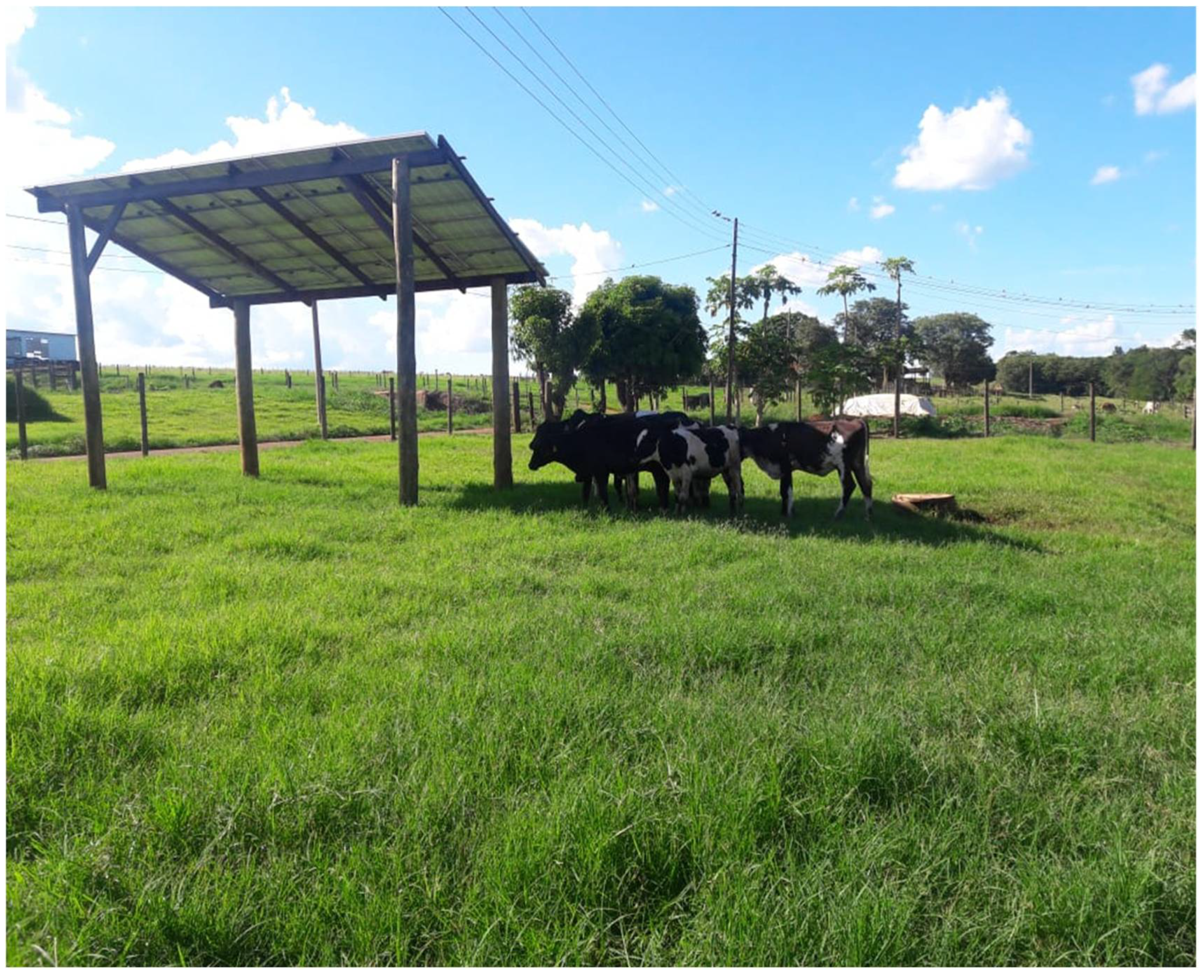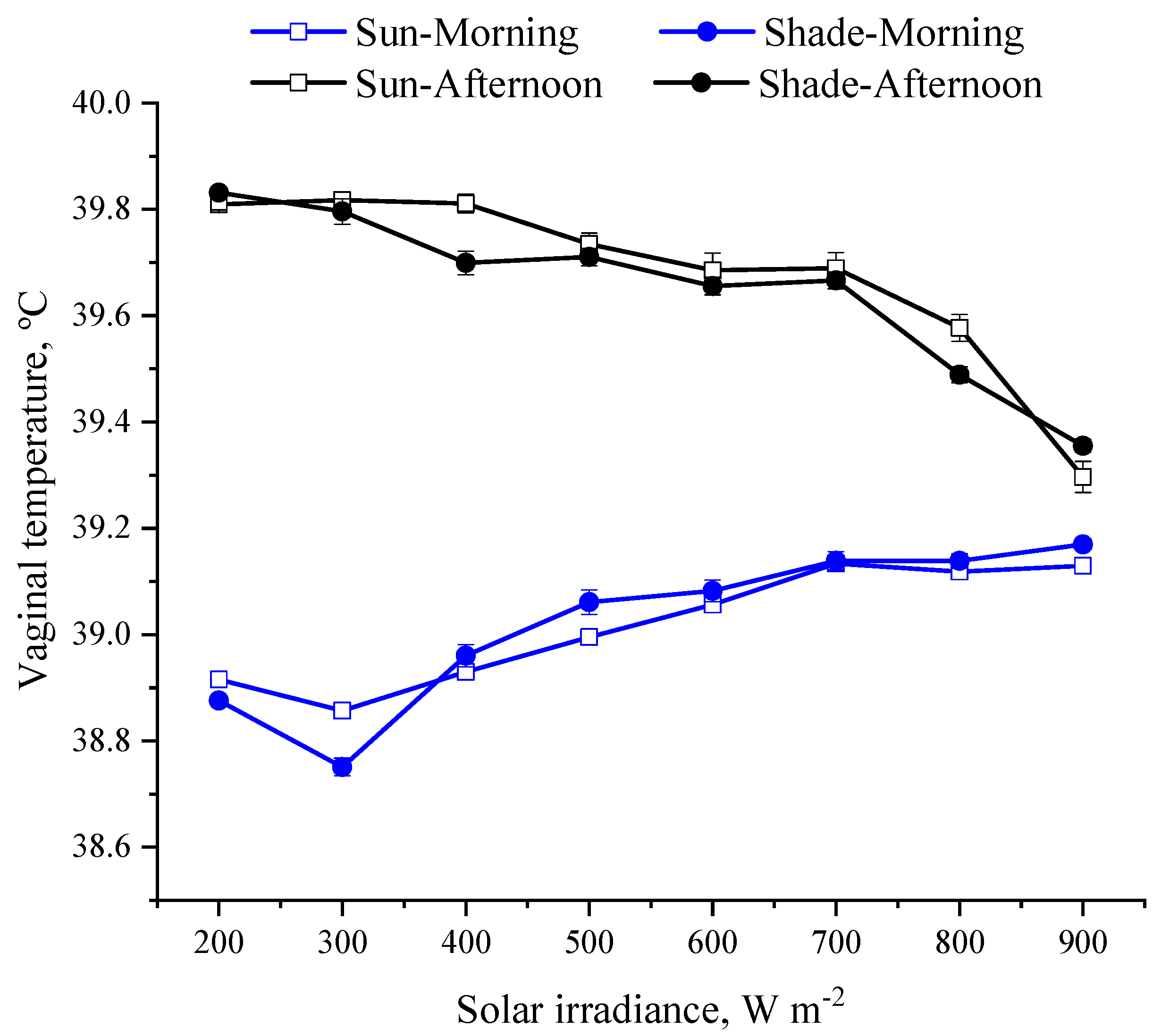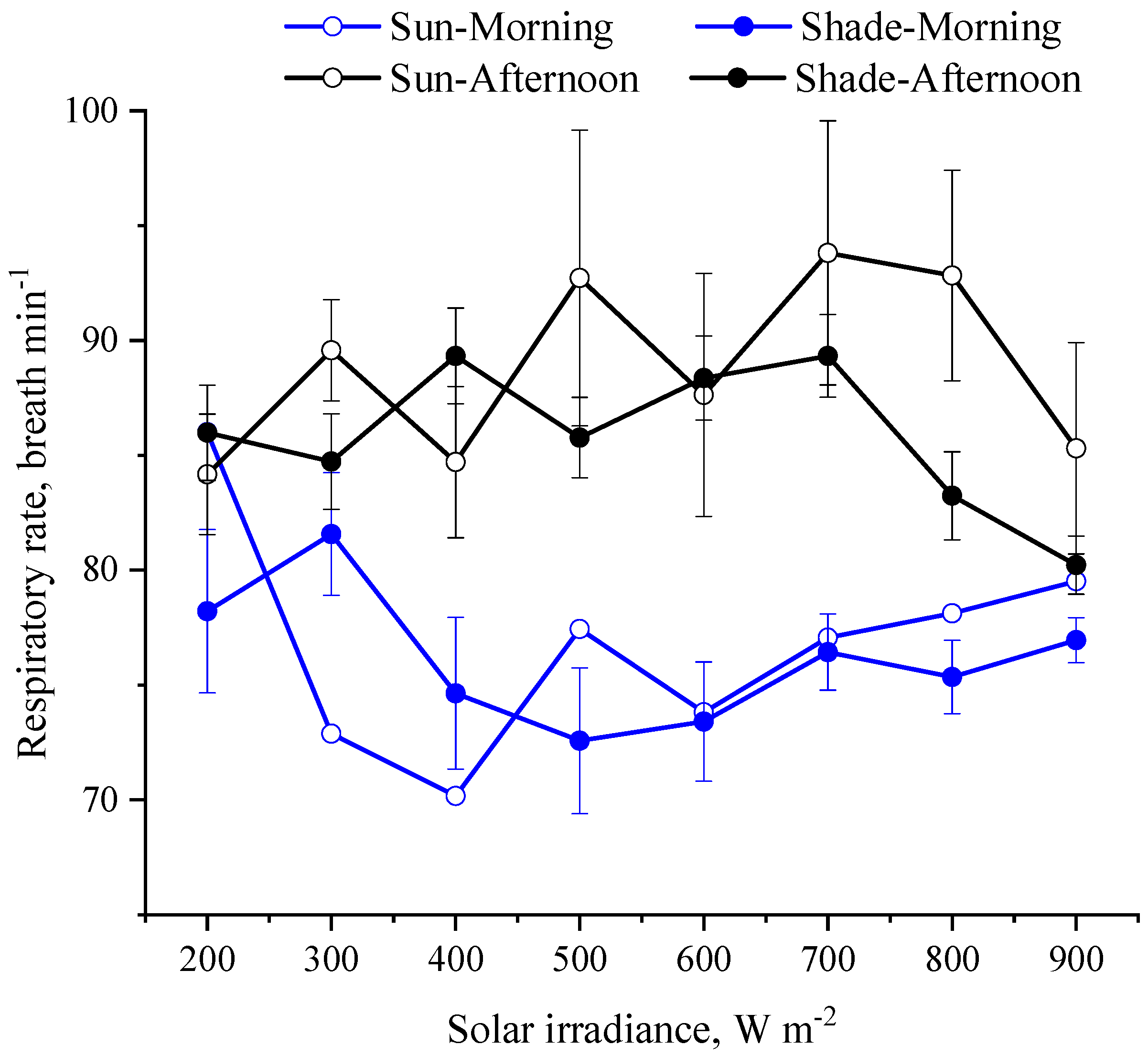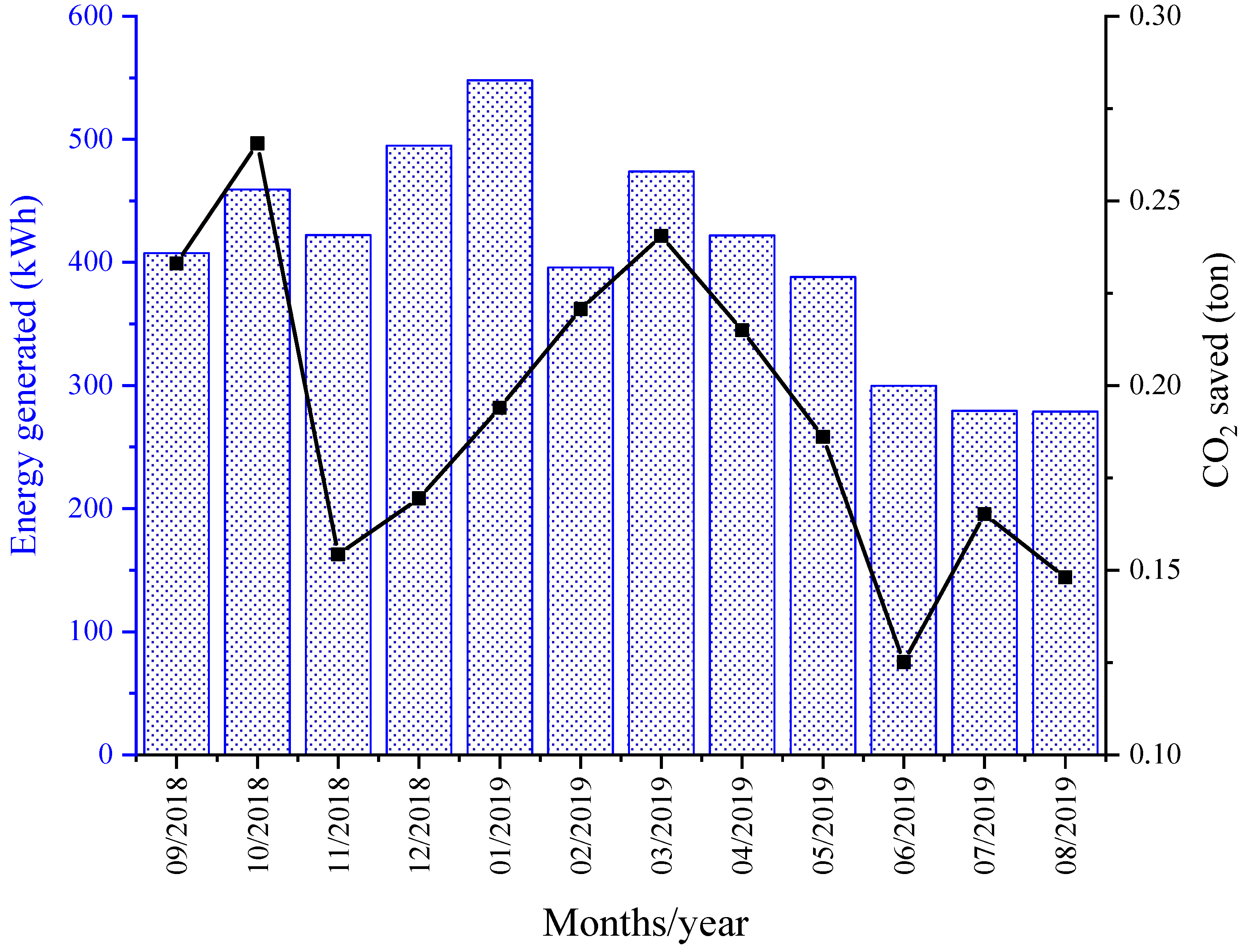Use of Solar Panels for Shade for Holstein Heifers
Abstract
:Simple Summary
Abstract
1. Introduction
2. Materials and Methods
2.1. Animals and Experimental Design
2.2. Meteorological Variables
2.3. Thermal Stress Indicators
2.3.1. Body Temperatures
2.3.2. Shade-Use Behavior
2.3.3. Thermal Evaluation of Shade of Solar Panels
2.3.4. Generation of Electricity, CO2 and CH4 Savings
2.4. Statistical Analyses
3. Results and Discussion
4. Conclusions
- It can be concluded that Animal Agrivoltaics in dairy systems in tropical climate have the potential and benefit in producing electricity, providing improved thermal comfort for cows, offsetting enteric methane emission to the environment, and become a source of income to farmers.
- The amount of CO2 saved by generating electricity by solar panels is sufficient to offset the amount of enteric methane emitted, provided that optimum amount of shade space is provided.
- Shade produced by solar panels reduced costs of thermoregulation on animals kept at conditions of high solar input (>1000 W m−2). As solar irradiance increased and the heifers were in shade, body surface temperature dropped by 6 °C and skin temperature by 4 °C.
Author Contributions
Funding
Institutional Review Board Statement
Informed Consent Statement
Data Availability Statement
Acknowledgments
Conflicts of Interest
References
- Brown-Brandl, T. Understanding heat stress in beef cattle. Braz. J. Anim. Sci. 2018, 47, 1–9. [Google Scholar] [CrossRef] [Green Version]
- Stetter, C.; Sauer, J. Greenhouse Gas Emissions and Eco-Performance at Farm Level: A Parametric Approach. Environ. Resour. Econ. 2022, 81, 617–647. [Google Scholar] [CrossRef]
- DaSilva, R.G.; Maia, A.S.C.; Costa, L.L.M. Index of thermal stress for cows (ITSC) under high solar radiation in tropical environments. Int. J. Biometeorol. 2015, 59, 551–559. [Google Scholar] [CrossRef] [PubMed]
- DaSilva, R.G.; Guilhermino, M.M.; Morais, D.A.E.F. Thermal radiation absorbed by dairy cows in pasture. Int. J. Biometeorol. 2010, 54, 5–11. [Google Scholar] [CrossRef]
- Castro, P.A.; Maia, A.S.C.; Fonsêca, V.D.F.C.; Moura, G.A.B.; de Melo Costa, C.C.; Nascimento, S.T.; Simão, B.R.; Ruggieri, A.C.; da Silva, R.G. Comparative methods analysis on rates of cutaneous evaporative water loss (CEWL) in cattle. J. Therm. Biol. 2021, 97, 102–109. [Google Scholar] [CrossRef]
- West, J.W. Effects of Heat-Stress on Production in Dairy Cattle. J. Dairy Sci. 2003, 86, 2131–2144. [Google Scholar] [CrossRef]
- Domingos, H.G.T.; Maia, A.S.C.; Souza, J.B.F., Jr.; Silva, R.B.; Vieira, F.M.C.; DaSilva, R.G. Effect of shade and water sprinkling on physiological responses and milk yields of Holstein cows in a semi-arid region. Livest. Sci. 2013, 154, 169–174. [Google Scholar] [CrossRef]
- Maia, A.S.C.; Culhari, E.A.; Fonsêca, V.F.C.; Milan, H.F.M.; Gebremedhin, K.G. Photovoltaic panels as shading resources for livestock. J. Clean. Prod. 2020, 258, 120551. [Google Scholar] [CrossRef]
- Moura, G.B.; Maia, A.S.C.; Araújo, V.; Milan, H.F.M.; Pacheco, R.; Fonseca, V.F.C. Photovoltaic panels as shading resources enhance environmental sustainability for feedlot cattle. In Proceedings of the 8th International Greenhouse Gas and Animal Agriculture Conference (GGAA), Orlando, FL, USA, 5–10 June 2022. [Google Scholar]
- Martin, P.; Bateson, P. Measuring Behaviour: An Introductory Guide; Cambridge University Press: Cambridge, UK, 2007. [Google Scholar]
- Schütz, K.E.; Cox, N.R.; Tucker, C.B. A field study of the behavioral and physiological effects of varying amounts of shade for lactating cows at pasture. J. Dairy Sci. 2014, 97, 3599–3605. [Google Scholar] [CrossRef]
- DaSilva, R.G.; Maia, A.S.C. Principles of Animal Biometeorology; Springer: New York, NY, USA, 2013; pp. 1–37. [Google Scholar]
- MCTIC. Brazilian Ministry of Science, Technology, Innovation and Communication. CO2 Emission Factors for the Generation of Electrical Energy in the Brazilian National Interconnected System; MCTIC: Brasilia, Brazil, 2018. Available online: https://www.gov.br/mcti/pt-br/search (accessed on 1 December 2022).
- MCTIC. Brazilian Ministry of Science, Technology, Innovation and Communication. CO2 Emission Factors for the Generation of Electrical Energy in the Brazilian National Interconnected System; MCTIC: Brasilia, Brazil, 2019. Available online: https://www.gov.br/mcti/pt-br/search (accessed on 1 December 2022).
- Schettini, B.L.; Jacovine, L.A.G.; Oliveira Neto, S.N.; Torres, C.M.; Rocha, J.S.S.; Villanova, P.H.; Magalhães, A.; Obolari, M.; Rufino, M.P.M. Silvopastoral systems: How to use them for carbon neutral milk production? Carbon Manag. 2021, 12, 377–384. [Google Scholar] [CrossRef]
- Nascimento, S.T.; Maia, A.S.C.; Fonsêca, V.F.C.; Nascimento, C.C.N.; Carvalho, M.D.; Pinheiro, M.G. Physiological responses and thermal equilibrium of Jersey dairy cows in tropical environment. Int. J. Biometeorol. 2019, 63, 1487–1496. [Google Scholar] [CrossRef] [PubMed]
- Maia, A.S.; Gebremedhin, K.G.; Nascimento, S.T.; Carvalho, M.D.; Simão, B.R.; Camerro, L.Z.; Neto, M.C. Development of Facial Masks for Indirect Calorimetric Studies for Livestock; American Society of Agricultural and Biological Engineers: St. Joseph, MI, USA, 2014; pp. 1–4. [Google Scholar]
- Littell, R.C. SAS for Mixed Models, 2nd ed.; SAS Institute, Inc.: Cary, NC, USA, 2006. [Google Scholar]
- Oliveira, S.E.O.; Costa, C.C.M.; Souza Junior, J.B.F.; Queiroz, J.P.A.F.; Maia, A.S.C.; Costa, L.L.M. Short-wave solar radiation level willingly tolerated by lactating Holstein cows in an equatorial semi-arid environment. Trop. Anim. Health Prod. 2014, 46, 1413–1420. [Google Scholar] [CrossRef] [PubMed]
- Oliveira, S.E.O.; Costa, C.C.M.; Chiquitelli Neto, M.; Dalla Costa, F.A.; Maia, A.S.C. Effects of shade location and protection from direct solar radiation on the behavior of Holstein cows. Int. J. Biometeorol. 2019, 63, 1465–1474. [Google Scholar] [CrossRef] [PubMed]
- Berman, A.; Horovitz, T. Radiant heat loss, an unexploited path for heat stress reduction in shaded cattle. J. Dairy Sci. 2012, 95, 3021–3031. [Google Scholar] [CrossRef] [PubMed] [Green Version]
- Tucker, C.B.; Rogers, A.R.; Schütz, K.E. Effect of solar radiation on dairy cattle behaviour, use of shade and body temperature in a pasture-based system. Appl. Anim. Behav. Sci. 2008, 109, 141–154. [Google Scholar] [CrossRef]
- Moura, G.A.B.; de Melo Costa, C.C.; Fonsêca, V.F.C.; Wijffels, G.; Castro, P.A.; Neto, M.C.; Maia, A.S.C. Are crossbred cattle (F1, Bos indicus x Bos taurus) thermally different to the purebred Bos indicus cattle under moderate conditions? Livest. Sci. 2021, 246, 104–457. [Google Scholar] [CrossRef]
- Fonsêca, V.F.C.; DaSilva, R.G.; Moura, G.A.; Snelling, E.P.; Fuller, A.; Mitchell, D.; Costa, C.C.M.; Milan, H.M.; Maia, A.S. Reliability of methods to determine cutaneous evaporative water loss rate in furred and fleeced mammals. J. Exp. Zool. A 2022, 337, 356–365. [Google Scholar] [CrossRef]
- Sharpe, K.T.; Heins, B.J.; Buchanan, E.S.; Reese, M.H. Evaluation of solar photovoltaic systems to shade cows in pasture-based dairy herd. J. Dairy Sci. 2021, 104, 2794–2806. [Google Scholar] [CrossRef]
- Schütz, K.E.; Rogers, A.R.; Poulouin, Y.A.; Cox, N.R.; Tucker, C.B. The amount of shade influences the behavior and physiology of dairy cattle. J. Dairy Sci. 2010, 93, 125–133. [Google Scholar] [CrossRef] [Green Version]
- Hristov, A.N.; Melgar, A.; Wasson, D.; Arndt, C. Effective nutritional strategies to mitigate enteric methane in dairy cattle. J. Dairy Sci. 2021, 105, 8543–8557. [Google Scholar] [CrossRef]
- Santos, S.G.C.G.; Saraiva, E.P.; Gonzaga Neto, S.; Maia, M.I.L.; Lees, A.M.; Sejian, V.; Maia, A.S.C.M.; Fonsêca, V.F.C.F. Heat tolerance, thermal equilibrium and environmental management strategies for dairy cows living in intertropical regions. Front. Vet. Sci. 2022, 9, 988775. [Google Scholar] [CrossRef] [PubMed]








| 24 h | 08:00–17:00 h | |||
|---|---|---|---|---|
| Meteorological Variables | Mean | Range | Mean | Range |
| Air temperature, °C | 23.8 | 12.4–33 | 28.0 | 20.4–33.0 |
| Solar irradiance, W m−2 | 219.3 | 0–1100 | 553.2 | 24.5–1100 |
| Relative humidity, % | 81.4 | 35.8–100.00 | 64.9 | 35.80–100.00 |
| Wind speed, m s−1 | 0.5 | 0–3.3 | 0.9 | 0–3.3 |
Disclaimer/Publisher’s Note: The statements, opinions and data contained in all publications are solely those of the individual author(s) and contributor(s) and not of MDPI and/or the editor(s). MDPI and/or the editor(s) disclaim responsibility for any injury to people or property resulting from any ideas, methods, instructions or products referred to in the content. |
© 2023 by the authors. Licensee MDPI, Basel, Switzerland. This article is an open access article distributed under the terms and conditions of the Creative Commons Attribution (CC BY) license (https://creativecommons.org/licenses/by/4.0/).
Share and Cite
Faria, A.F.P.A.; Maia, A.S.C.; Moura, G.A.B.; Fonsêca, V.F.C.; Nascimento, S.T.; Milan, H.F.M.; Gebremedhin, K.G. Use of Solar Panels for Shade for Holstein Heifers. Animals 2023, 13, 329. https://doi.org/10.3390/ani13030329
Faria AFPA, Maia ASC, Moura GAB, Fonsêca VFC, Nascimento ST, Milan HFM, Gebremedhin KG. Use of Solar Panels for Shade for Holstein Heifers. Animals. 2023; 13(3):329. https://doi.org/10.3390/ani13030329
Chicago/Turabian StyleFaria, Ana Flávia P. A., Alex S. C. Maia, Gustavo A. B. Moura, Vinícius F. C. Fonsêca, Sheila T. Nascimento, Hugo F. M. Milan, and Kifle G. Gebremedhin. 2023. "Use of Solar Panels for Shade for Holstein Heifers" Animals 13, no. 3: 329. https://doi.org/10.3390/ani13030329





